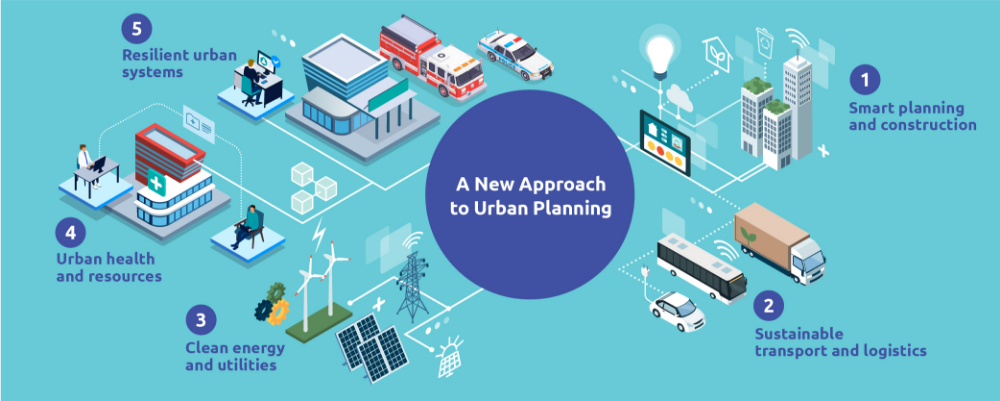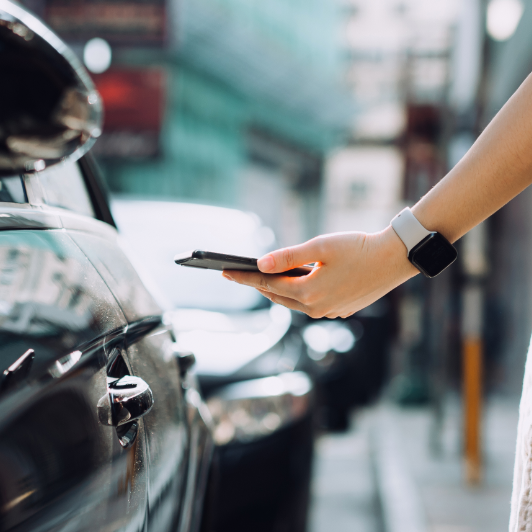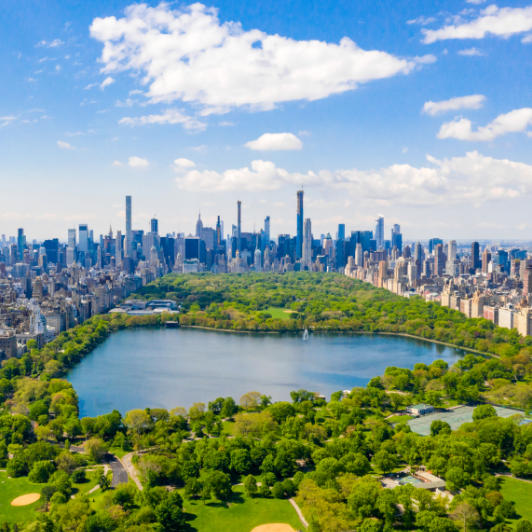Published: Sep 09, 2022
smart at scale — a sustainable approach to urban development
Introduction
The world’s urban population has exploded in the past few decades and continues to grow rapidly year by year. The United Nations (UN) estimates that two-thirds of all humanity will live in cities by 2050.
Increasingly, urban population growth is concentrated in the developing world. By 2050, nearly 90 percent of new urbanites will dwell in cities in Asia and Africa, according to the same UN report.
This level of urbanisation brings major challenges from a sustainability point of view. Water shortages, air pollution, high levels of energy consumption, and poor waste management are just some of the problems associated with large cities. These things not only harm the environment and contribute to climate change, they are also detrimental to the health and general wellbeing of city dwellers.
Making cities more sustainable should therefore be a top priority for governments and urban planners around the world. This requires a smarter approach to city planning and a willingness to embrace and leverage new technological innovations.
A new approach to urban planning
There are a number of things cities can do to improve the quality of life of all residents while ensuring a more sustainable future. Let’s look at five key areas of focus as well as some real-world examples of how cities are meeting the complex needs of their growing populations while mitigating the environmental impact of urbanisation.
The communities in this article – their leaders, public officials, administrators, businesses, and universities – have taken extraordinary steps to render the urban environment more inclusive, equitable, agile, open to new ideas and, ultimately, resilient.

1. Smart planning and construction to make better use of the built environment
According to an India-based urban planning and development think tank, a study of 50 cities around the world found that “60 percent of growth in energy consumption is directly related to urban sprawl, surpassing the impact of GDP and population growth.” Thus, minimising urban sprawl is essential to building a more sustainable future.
This can be achieved by focusing on compact, well-connected mixed-use developments. To that end, city planners should look for ways to get the most out of urban spaces, such as:
- Making use of advanced technologies such as digital twin, 3D maps, and applied analytics in the process of planning smart cities, towns, and villages
- Constructing multifunctional buildings to optimise the use of floor space
- Improving construction efficiency by using prefabricated, flexible, and reusable building parts
- Ensuring smart residential and commercial building management to make energy and water use more efficient and reduce costs
A number of governments around the world are already using digital twins, which are essentially virtual representations of objects, systems, or places based on real-world data, to enhance urban planning. For example, the government of the state of Victoria in Australia announced last year that it will spend nearly AUD35 million to build a digital twin of the state which planners, engineers, and builders will be able to use to model and test different scenarios before making major investments in urban development.
Rennes Métropole in France has also chosen to use 3D visualisation. According to Dassault Systèmes, the company tasked with building the model, it will “facilitate remote data sharing in order to simulate, plan and manage the city in a transversal and collaborative way, to develop effective public policies.”
Singapore is another city which has taken this approach. A digital twin is being used to plan Punggol Digital District, a new 50-hectare smart mixed-use district being developed in the north-east region of the city.
2. Sustainable transport and logistics to increase mobility and connectivity
A transportation network that allows the efficient movement of people and goods between districts is fundamental to any well-functioning city. However, the transportation systems in many cities are overburdened, which means poor air quality, long travel times, and costly journeys.
Urban planners need to rethink transportation in order to reduce its environmental impact and improve the quality of life of all city dwellers. This entails, among other things:
- Monitoring and managing traffic in real-time with geospatial information systems
- Focusing on transit-oriented development — i.e., establishing dense, integrated, and mixed-use communities close to transport nodes
- Embracing platforms that allow citizens to access mobility solutions that are suitable for their specific needs
NCS is working with MSI Global Private Limited, a subsidiary of the Land Transport Authority (LTA), to provide intelligent transport solutions that harness technologies like artificial intelligence (AI), automation, mobility as a service (MaaS), cellular vehicle-to-everything (CV2X) connectivity, and advanced analytics. The goal is to help digitalise the land transport industry and improve commuter experience and engagement. Moreover, our subsidiary DataSpark processes large geospatial temporal mobility data to provide intelligence on people and places which can be used to improve transportation infrastructure planning.
Another example of intelligent transportation management comes from Japan. Toyota has implemented an Intelligent Transport System (ITS) Smart Pole to reduce traffic accidents in Toyota City. The pole is installed at a complicated road junction and uses cameras and sensors to monitor the movements of vehicles and pedestrians in the vicinity. An LED signboard displays alerts to those approaching the junction without right of way.
3. Clean energy and utilities to improve efficiency of urban systems and the environment
Cities account for 78 percent of global energy consumption and more than 60 percent of greenhouse gas emissions despite covering less than two percent of the earth’s surface, according to UN Habitat. Cities are therefore on the front line of the fight against climate change and should be doing everything possible to reduce the use of energy generated from fossil fuels.
Some solutions currently being implemented in cities around the world include:
- Decentralised renewable energy generation and distribution through, for example, rooftop solar panels and peer-to-peer energy trading systems
- Waste-to-energy plants which are connected to heat networks
- Buildings equipped with temperature sensors, smart meters, and occupant-centric controls in order to more effectively control energy and water use and reduce waste
- Intelligent grid management to help utilities make their operations more efficient and cost-effective
Singapore is investing heavily in renewables like solar energy. The city achieved its 2020 solar panel target of 350 megawatt-peak (MWp) in the first quarter of that year. It plans to add at least two gigawatt-peak (GWp) of solar panels by 2030 and at least 200 megawatts of energy storage beyond 2025.
Given Singapore’s high population density and lack of space, the city has been pushing the development of innovative solar solutions that are suited to urban environments in addition to more conventional solutions like rooftop solar panels. Examples include building facades that can generate power from the sun, movable solar power systems, and floating solar power plants.
Meanwhile, NCS is helping drive the Housing & Development Board’s (HDB) sustainability and community development efforts through Smart Hub, which collects data from sensors connected to things like solar panels, lights, smart water pumps, and lifts in residential estates and monitors the data for anomalies. The data is used to assess and maintain the effectiveness of these assets and identify energy consumption patterns to improve energy efficiency.
4. Urban health and resources to improve liveability and affordability
One of the biggest challenges for cities is ensuring that crucial services like healthcare, education, and public safety are available to everyone even as the population expands.
Cities need to digitalise these services as much as possible to ensure that they are accessible and user-friendly for all, including the elderly, people with disabilities, and other vulnerable individuals.
Increasingly, technology is being used to make education in urban areas more inclusive. For example, schools are installing high-speed internet connections and embracing remote learning tools.
Meanwhile, healthcare is being democratised by telemedicine services which allow healthcare practitioners to diagnose and treat patients and share expertise with colleagues remotely. Thanks to advances in robotics and other technologies, it will soon even be possible for surgeons to operate on patients without being in the same physical location.
AI is also playing a larger role in healthcare, ensuring that some aspects of care can be automated. For example, NCS has developed an AI-powered fall prevention solution. The solution is based on the Edge Intelligence Video-Based Analytic Camera, an edge device developed by NCS CorpLabs, which monitors a patient’s movements and alerts healthcare professionals when the probability of the patient falling is more than 95 percent.
Sustainable healthcare also involves ensuring that elderly, disabled, or infirm individuals can live in their own homes with a minimal amount of professional care. Fukuoka in Japan, for instance, has implemented a system for looking after its ageing population which involves the Internet of Things (IoT) and local communities. Under the system, local service providers like electricians and postal workers check on elderly residents in their homes on a daily basis assisted by “CareTech” solutions which leverage various technologies to monitor seniors.
5. Resilient urban systems to enable cities to prepare for, and withstand, environmental shocks and disasters
Cities need to be able to respond quickly to public emergencies like natural disasters, especially those located in areas that are prone to earthquakes or extreme weather. They also need to be prepared for things like civil unrest, acts of terrorism, and cyber-attacks, all of which can have knock-on environmental impacts since they may cause funds to be diverted away from important sustainability initiatives.
There is a range of solutions cities can adopt to boost preparedness for these kinds of events, including:
- Smart urban management systems that allow the city to adapt quickly to change and respond effectively to public emergencies
- AI-powered predictive analytics to better monitor and forecast risk
- Urban infrastructure and buildings that are built to withstand natural and manmade disasters
Technologies like virtual reality (VR) are being used by some cities to simulate disasters and prepare response strategies. In Singapore, for example, VR is being used to provide enhanced training to emergency medical responders.
Cities can use the IoT and tools like predictive analytics to monitor tremors and other natural hazards in real time and trigger evacuation warnings automatically. Indonesia’s PetaBencana.id, for example, provides real-time flood mapping in Jakarta using data from multiple open-source sensors as well as information crowd-sourced from social media.
Conclusion
New and emerging technologies are radically reshaping the way we plan and manage urban environments. It is essential that cities tap the full potential of these technologies if they are to remain liveable for future generations. This is a challenge that can only be properly addressed if local communities and private and public sector entities, including policymakers, city planners, technologists, environmentalists, and corporations, come together to share their concerns, exchange information and ideas, and work towards making urban development more sustainable and inclusive.



